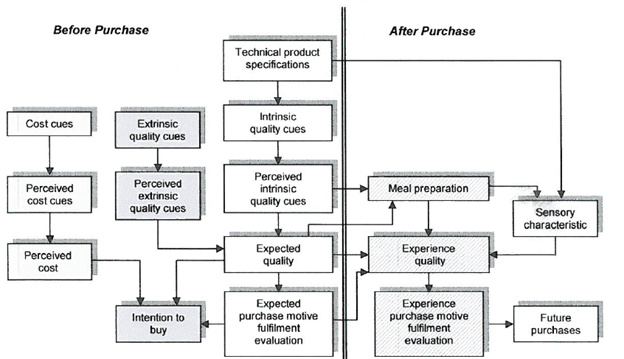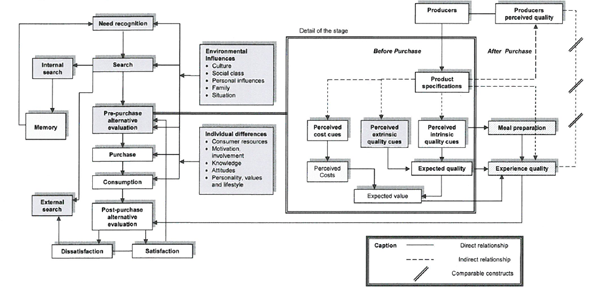The Quality Concept
Food quality is not an inherent characteristic of the food but is closely allied with the concept of acceptability and, therefore, it is more relevant to speak about perceived quality. Consumer perceptions of product quality may find their base in the physical characteristics of the product, in communication around the product, or in a combination of both. Perceived quality is what will motivate a consumer to buy a product for usage. Additionally, perceived quality depends on the person and on the context, i.e., on the circumstances in which food and consumer interact, and changes in perception occur for a person through experience and, for a given population over time.
Building on the material discussed above, it can be said that understanding and explaining the process of food evaluation and choice is to understand and explain the perception process of food quality.
The Total Food Quality Model (TFQM)
The integrative approaches try to integrate the other approaches into a unified framework for the analysis of the quality perception process for food products. TFQM is the distinction between before and after purchase evaluations. Most food products have search characteristics only to a limited degree. To make a choice, the consumer will develop quality expectations, but it is only after consumption that experienced quality can be determined, and even this is limited in the case of credence characteristics.
The pre-purchase component of the model shows how quality expectations are formed based on the quality cues available. The intrinsic quality cues are related to the product’s technical specifications, i.e., characteristics that can be measured objectively. The extrinsic quality cues represent all other characteristics, such as brand name, price, packaging, etc. Of all the cues consumers are exposed to, only those which are perceived will have an influence on expected quality.

According to the TFQM, quality is not an aim but is desired because it helps to satisfy purchase motives or values. The values sought by consumers will, in turn, have an impact on which quality dimensions are sought and how different cues are perceived and evaluated. Expected quality and expected fulfilment of purchase motives constitute the positive consequences consumers expect from buying a food product and are offset against the negative consequences in the form of costs. The trade-off determines intention to buy. Price can be both a cost cue and an extrinsic quality cue.
After the purchase, the consumer will have a quality experience, which often deviates from the expected quality. The experienced quality is influenced by many factors: the product itself, especially its sensory characteristics, but also the way the product has been prepared; situational factors such as type of meal, previous experience, etc. The relationship between quality expectation and quality experience is believed to determine product satisfaction and, consequently, the probability of purchasing the product again.
Consumers’ quality perception and experience are particularly important in food consumption behaviour since food products are experience products. That is the reason why several researchers have concentrated their work on studying the formation of consumers’ food quality expectations and experiences, as determinants of food choice. However, as with any other decision about consumption or buying of a product, food choice is influenced by a set of factors such as attitudes, information, motives, previous knowledge, etc.

Click on the link(s) below to open the resources.